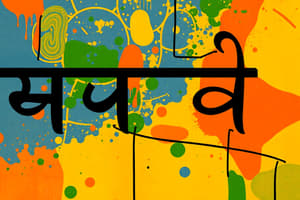Podcast
Questions and Answers
Which of the following best describes the origin and development of Modern Standard Hindi?
Which of the following best describes the origin and development of Modern Standard Hindi?
- Based on the Khariboli dialect, evolving from Sanskrit through Prakrit and Apabhramsa. (correct)
- Developed as a creole language blending English and Sanskrit.
- Evolved from Persian, incorporating elements of Turkish and Arabic.
- Evolved directly from Latin, similar to the Romance languages.
What is the significance of grammatical gender in Hindi, and how does it compare to its role in English?
What is the significance of grammatical gender in Hindi, and how does it compare to its role in English?
- Grammatical gender is significant in Hindi, affecting verb conjugation, but plays no role in modern English. (correct)
- Both Hindi and English use grammatical gender to determine word order.
- Grammatical gender is only relevant in formal Hindi, while English uses it extensively in literature.
- Neither Hindi nor English uses grammatical gender; both rely on noun-verb agreement instead.
How does the writing system of Hindi differ from that of English?
How does the writing system of Hindi differ from that of English?
- Hindi utilizes the Latin alphabet with added diacritics, while English uses the Devanagari script.
- Both Hindi and English use the same writing system, but Hindi includes additional symbols for complex sounds.
- Both Hindi and English use an abugida system where vowels are inherent in consonants.
- Hindi uses the Devanagari script, an abugida where consonants have inherent vowels, while English uses the Latin alphabet. (correct)
In what way does the word order of Hindi contrast with that of English?
In what way does the word order of Hindi contrast with that of English?
Which of the following statements accurately describes 'code-switching' as it relates to Hinglish?
Which of the following statements accurately describes 'code-switching' as it relates to Hinglish?
What characterizes the grammatical structure of Hinglish?
What characterizes the grammatical structure of Hinglish?
Why is English orthography often considered inconsistent?
Why is English orthography often considered inconsistent?
Which statement accurately reflects the mutual intelligibility between Hindi and Urdu?
Which statement accurately reflects the mutual intelligibility between Hindi and Urdu?
What factor primarily contributes to English vocabulary including words from a wide range of languages?
What factor primarily contributes to English vocabulary including words from a wide range of languages?
What is a key difference between Hindi and English concerning the use of pronouns?
What is a key difference between Hindi and English concerning the use of pronouns?
Which term accurately describes the Devanagari script used for writing Hindi?
Which term accurately describes the Devanagari script used for writing Hindi?
What factor has significantly contributed to the increased usage of Hinglish in India?
What factor has significantly contributed to the increased usage of Hinglish in India?
Why is Hinglish generally not considered a formal or standardized language?
Why is Hinglish generally not considered a formal or standardized language?
How did Latin influence the development of the English language?
How did Latin influence the development of the English language?
What is a retroflex consonant, and in which of the languages, Hindi or English, are they found?
What is a retroflex consonant, and in which of the languages, Hindi or English, are they found?
Which language family do Hindi and English belong to, and what does this indicate about their relationship?
Which language family do Hindi and English belong to, and what does this indicate about their relationship?
How can the evolution of English be described from the 5th and 6th centuries onwards?
How can the evolution of English be described from the 5th and 6th centuries onwards?
What distinguishes Hindi as a pro-drop language compared to English?
What distinguishes Hindi as a pro-drop language compared to English?
What role do auxiliary verbs play in English grammar?
What role do auxiliary verbs play in English grammar?
How does verb conjugation in Hindi differ from verb conjugation in English?
How does verb conjugation in Hindi differ from verb conjugation in English?
Flashcards
What is Hindi?
What is Hindi?
An Indo-Aryan language spoken primarily in India and one of the official languages of the Union Government of India.
What is English?
What is English?
A West Germanic language that originated in England and is one of the most widely spoken languages globally.
What is Devanagari?
What is Devanagari?
The script used to write Hindi, characterized as an abugida where consonants have an inherent vowel.
What is code-switching?
What is code-switching?
Signup and view all the flashcards
What is Hinglish?
What is Hinglish?
Signup and view all the flashcards
What are the language families?
What are the language families?
Signup and view all the flashcards
What is a pro-drop language?
What is a pro-drop language?
Signup and view all the flashcards
What is verb conjugation?
What is verb conjugation?
Signup and view all the flashcards
What are loanwords?
What are loanwords?
Signup and view all the flashcards
What is Khariboli?
What is Khariboli?
Signup and view all the flashcards
What is the Latin alphabet?
What is the Latin alphabet?
Signup and view all the flashcards
What is inconsistent orthography?
What is inconsistent orthography?
Signup and view all the flashcards
What is word order?
What is word order?
Signup and view all the flashcards
What are English's sources?
What are English's sources?
Signup and view all the flashcards
What is code-switching in Hinglish?
What is code-switching in Hinglish?
Signup and view all the flashcards
What are Hinglish hybrid words?
What are Hinglish hybrid words?
Signup and view all the flashcards
Study Notes
- Hindi and English are distinct languages with different origins and linguistic structures
- Though distinct, there is code-switching between Hindi and English, commonly referred to as "Hinglish"
Hindi
- Hindi is an Indo-Aryan language spoken primarily in India
- It is one of the official languages of the Union Government of India
- Hindi evolved from Sanskrit through Prakrit and Apabhramsa
- Modern Standard Hindi is based on the Khariboli dialect
- It is mutually intelligible with Urdu; these are often considered dialects of the same language, Hindustani
- Hindi is written in the Devanagari script
- Devanagari is an abugida, meaning that each consonant has an inherent vowel
- Other vowels can be indicated using diacritics
- Hindi grammar includes features such as noun-verb agreement
- Grammatical gender impacts verb conjugation
- Hindi vocabulary draws heavily from Sanskrit and Prakrit
- It has also absorbed words from Persian, Arabic, Turkish, and English
English
- English is a West Germanic language that originated in England
- It is one of the most widely spoken languages globally
- English developed from the dialects spoken by Germanic tribes who migrated to Britain in the 5th and 6th centuries
- It has been heavily influenced by Latin, Norman French, and other languages
- English is generally written in the Latin alphabet
- It uses a set of 26 letters
- English orthography can be inconsistent
- The relationship between spelling and pronunciation is not always straightforward
- English grammar relies on word order
- It also relies on auxiliary verbs to indicate tense and aspect
- English vocabulary includes words from a wide range of languages due to its history of borrowing and adaptation
- It includes Germanic, Latin, French, Greek, and many other sources
Linguistic Differences
- Hindi and English belong to different language families
- Hindi is Indo-European and English is also Indo-European, but from different branches
- Hindi uses the Devanagari script, while English uses the Latin alphabet
- Hindi is a pro-drop language
- Pronouns can be omitted when they are clear from context
- English generally requires pronouns
- Hindi has a relatively free word order compared to English
- Grammatical gender is significant in Hindi
- It plays no role in modern English
- Hindi verbs conjugate to agree with the gender and number of the subject
- English verb conjugation is simpler
- Hindi has retroflex consonants, which are not found in English
- English has a number of sounds not found in Hindi
- Hindi and English have different systems for indicating tense, aspect, and mood
- Hindi's case marking system differs significantly from English
Hinglish
- Hinglish is a mix of Hindi and English
- It involves code-switching and lexical borrowing between the two languages
- Code-switching is the practice of alternating between two or more languages in conversation
- Hinglish is commonly used in urban areas of India
- It can also be found in the Indian diaspora
- Hinglish can take various forms
- It ranges from isolated English words in Hindi sentences to more complex blends
- Hinglish reflects the influence of globalization
- It also reflects the increasing use of English in Indian society
- Some view Hinglish as a natural evolution of language
- Others see it as a threat to the purity of Hindi
- Hinglish is often used in media, advertising, and entertainment
- Grammatical structures tend to follow Hindi patterns
- There is often the incorporation of English vocabulary
- Some examples of Hinglish usage include
- Using English loanwords within Hindi sentences e.g. "I am going to the market."
- Creating hybrid words by combining Hindi and English components e.g. "timepass" (English "time" + Hindi "pass") means pastime.
- Hinglish is not typically considered a formal or standardized language
- The specific forms and usages vary widely
Studying That Suits You
Use AI to generate personalized quizzes and flashcards to suit your learning preferences.




